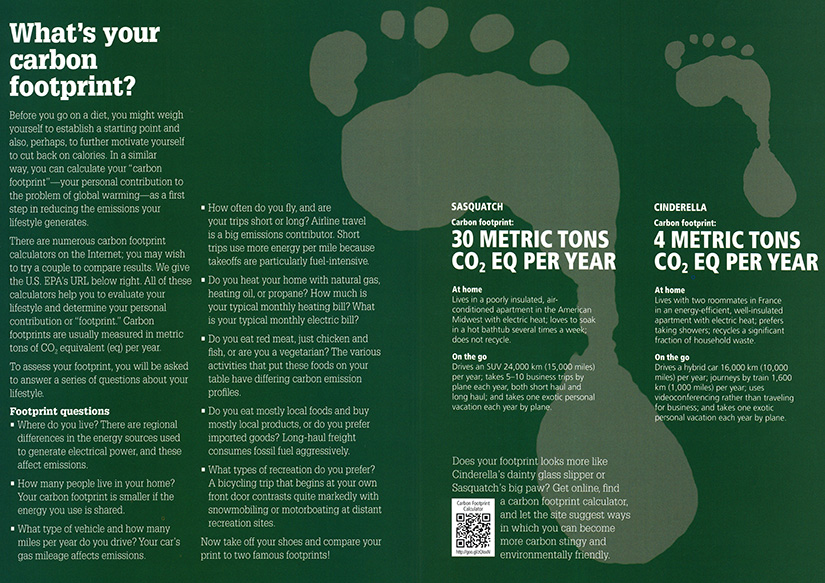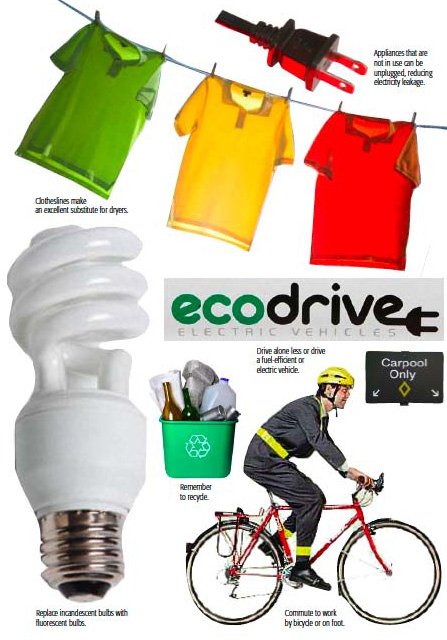We have already seen in this lesson that reducing carbon emissions will ultimately require policies to ensure that market-based economic decisions internalize the cost to society and the environment of emitting additional carbon. Clearly, there is, therefore, not only a role, but a need, for enacting governmental policies to incentivize moving away from practices that emit carbon, including fossil fuel burning.
This does not mean, however, that there is not also a role for the individual. Clearly, making more responsible individual choices can help in the process of reducing carbon emissions. As we saw earlier, the typical American adds 1 metric ton a year to the atmosphere via the use of a personal vehicle. Of course, they would have furthered additional transport-related emissions through air travel, and even through the food and various projects they purchase, many of which are transported large distances. Then, there is the energy we use to power our homes, etc. By the time all is said and done, the average American, through all of their collective activities and actions, will have effectively emitted roughly 20 metric tons of CO2 equivalent in a given year. Call this your carbon footprint. Calculate your personal carbon footprint using the US EPA's calculator here.

What's Your Carbon Footprint?
- Where do you live? There are regional differences in the energy sources used to generate electrical power, and these affect emissions.
- How many people live in your home? Your carbon footprint is smaller ID the energy you use is shared.
- What type of vehicle and how many miles per year do you drive? Your car's gas mileage affects emission.
- How often do you fly, and are your trips short or long? Airline travel is a big emissions contributor. Short trips use more energy per mile because takeoffs are particularly fuel-intensive.
- Do you heat your home with natural gas, heating oil, or propane? How much is your typical monthly heating bill? What is your typical monthly electric bill?
- Do you eat red meat, just chicken and fish, or are you a vegetarian? The various activities that put these foods on your table have differing carbon emission profiles.
- Do you eat mostly local foods and buy mostly local products, or do you prefer imported goods? Long-haul freight consumes fossil fuel aggressively.
- What types of recreation do you prefer? A bicycling trip that begins at your front door contrasts quite markedly with snowmobiling or motor boating at distant recreation sites.
Now take off your shoes and compare your print to two famous footprints!
Sasquatch
Carbon footprint: 30 metric tons CO2 EQ per year
- At home: Lives in a poorly insulated, air-conditioned apartment in the American Midwest with electric heat, loves to soak in a hot bathtub several times a week; does not recycle
- On the go: Drives an SUV 24,000 km (15,000 miles) per year, takes 5-10 business trips by plane each year, both short haul and long haul; and takes one exotic personal vacation each year by plane.
Cinderella
Carbon footprint: 4 metric tons CO2 EQ per year
- At home: Lives with two roommates in France in an energy-efficient, well-insulated apartment with electric heat; prefers taking showers; recycles a significant fraction of household waste
- One the go: Drives a hybrid car 16,000 km (10,000 miles) per year; journeys by train 1,600 km (1,000 miles) per year, uses videoconferencing rather than traveling for business; and takes one exotic personal vacation each year by plane.
Does your footprint look more like Cinderella's dainty glass slipper or Sasquatch's big paw? Get online, find a carbon footprint calculator, and let the site suggest ways in which you can become more carbon stingy and environmentally friendly.
© 2015 Pearson Education, Inc.
Just like real footprints, carbon footprints vary greatly in size. An especially gluttonous individual might emit as much as 30 metric tons a year through his actions—call him a "Sasquatch" (otherwise known as "big foot"). On the other hand, an individual with a more ascetic lifestyle might emit as little as 4 metric tons of CO2 equivalent per year—call her a "Cinderella".
Individuals, one might argue, must do their part in achieving the reductions necessary for achieving stabilization below dangerous levels. Recall that 80% below 1990 global emissions by mid-century, as required for 450 ppm stabilization, is about 5 gigatons CO2 equivalent per year, whereas current emissions are about 31 gigatons.
Think About It!
How close would the typical American have to come to being a "Cinderella" by 2050 to do their part in achieving the necessary reduction in emissions?
Click for answer.
Since average emissions are currently 20 tons/year, these emissions must be reduced to (5/31) x 20 = 3.2 gigatons/year, a bit lower than even "Cinderella"!
So, if you are a Sasquatch, or even just a typical emitter, what can you do to try to fit into Cinderella's shoes? Well, a picture is indeed worth a thousand words—see below.

- Appliances that are not in use can be unplugged, reducing electricity leakage.
- Clotheslines make an excellent substitute for dryers
- Drive alone less or drive a fuel-efficient or electric vehicle
- Remember to recycle
- Replace incandescent bulbs with fluorescent bulbs
- Commute to work by bicycle or on foot.
In many cases, as alluded to earlier in the lesson, there are simple no regrets strategies that can be taken to reducing one's own personal greenhouse gas emissions. Bicycling to work or to run errands is better for your health, as well as less expensive, than driving a car. Conserving energy by turning off appliances when they are not being used, buying energy-efficient appliances, compact fluorescent light bulbs, etc., lowers your energy bills. Many supermarkets give you a discount for using your own reusable canvas shopping bags, and many coffee shops give you a discount for using your own reusable container in place of a disposable paper cup. Other helpful practices such as the "Three Rs"—reducing, reusing, and recycling materials—are simply a matter of good stewardship, and make us feel better and help keep our environment clean. Of course, it is overly optimistic to imagine that civilization will make the major adjustments in lifestyle necessary to stabilize greenhouse gas concentrations based simply on no regrets strategies and an intrinsic commitment to better stewardship.
Policies that provide incentives for these types of behavior will have to play a key role.
